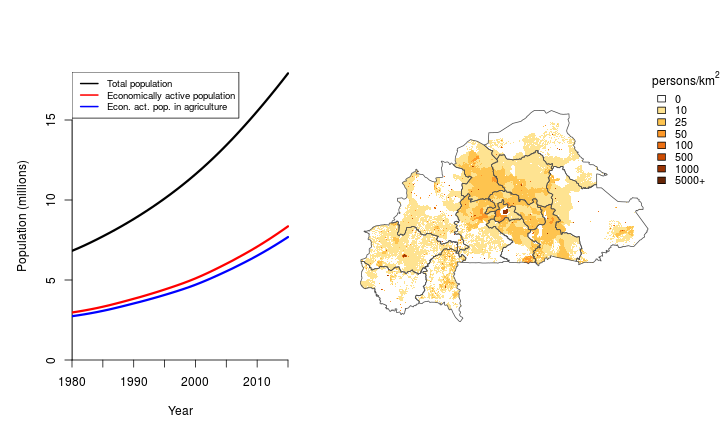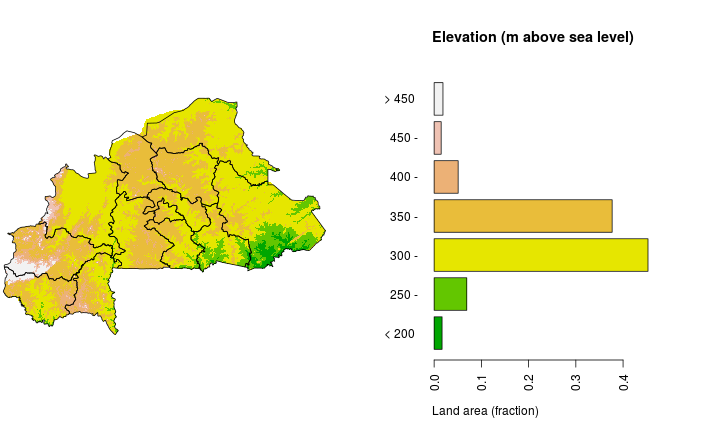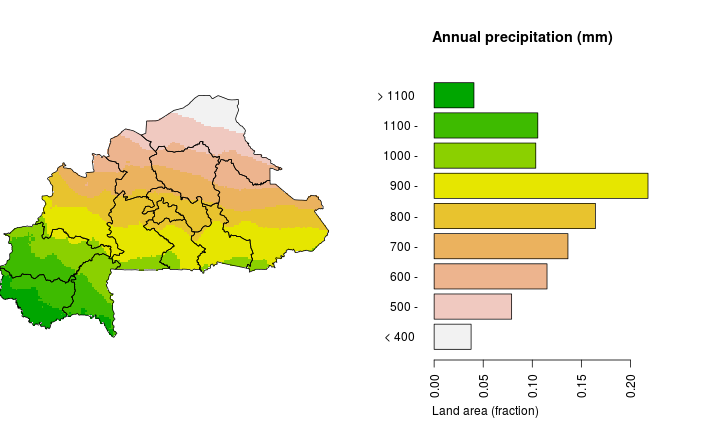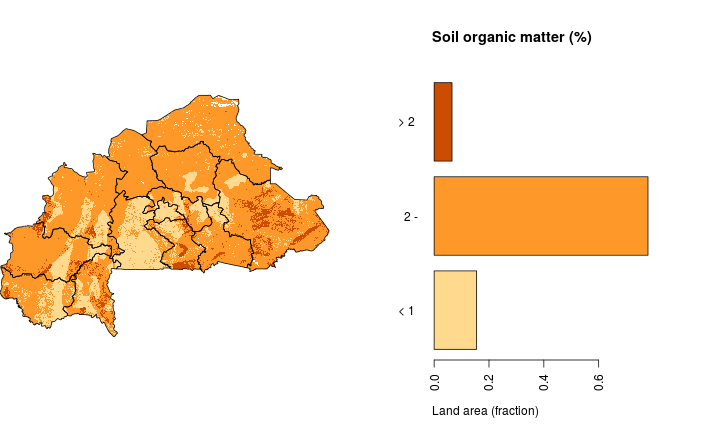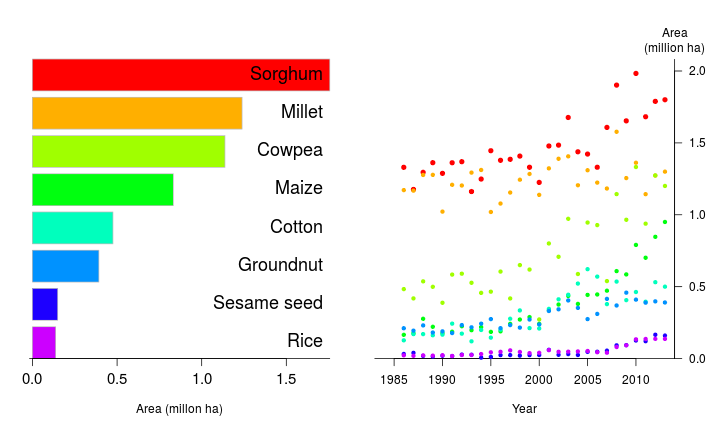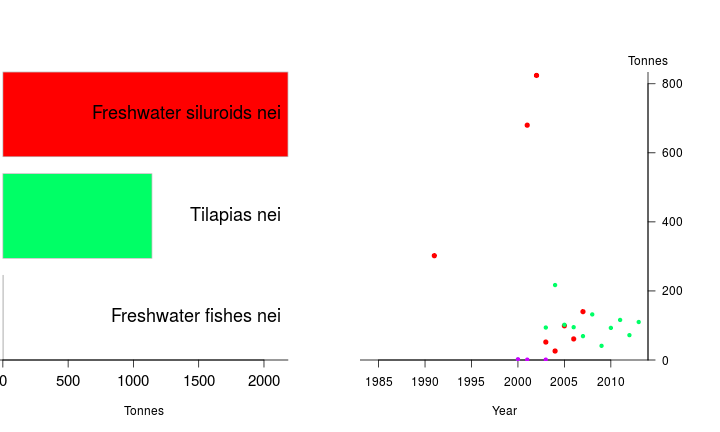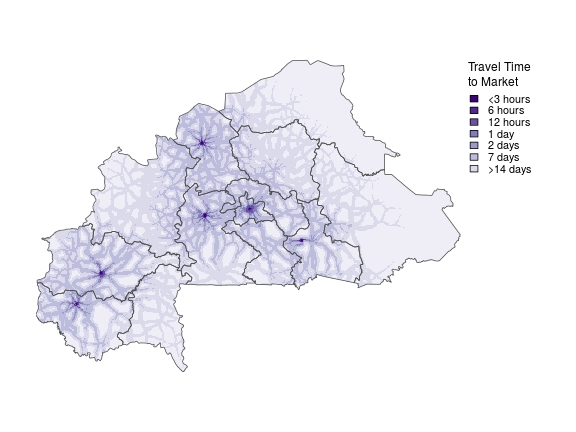Burkina Faso¶
Introduction¶
Burkina Faso is not one of USAID’s Feed the Future countries, but is a country frequently included in USAID’s Innovation Labs. It participates in the Lab for Climate-Resilient Cowpea, which focuses on cowpea breeding for drought and disease resistance. The Lab for Grain Legumes focuses on similar issues, including building genetic improvements to cowpea for overcoming drought and biotic constraints and researching scalable solutions for pest management of cowpea insects. The Lab for Market Access has several projects in Burkina Faso. One focuses on gender-based constraints to improved technology adoption for sorghum crops, and another addresses crop yield volatility in cotton.
Burkina Faso is located between a latitude between 9.4 °N and 15.1 °N. The total land area is about 274 thousand km2. The country is administratively subdivided into 13 Région (Regions), and these are further sub-divided into 45 Province .
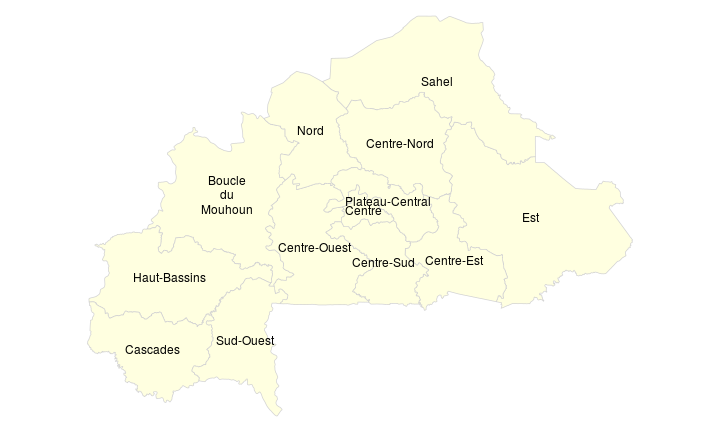
Administrative Divisons Map
The regions of Burkina Faso
Human development¶
Population¶
Burkina Faso has about 17.9 million inhabitants. The population has increased 2.3 fold over the past 30 years. The economically active population is 8.4 million, 92% of which is employed in agriculture (the same as in 1985). The rural population was 88% in 1985 and now it is 70%.
Development¶
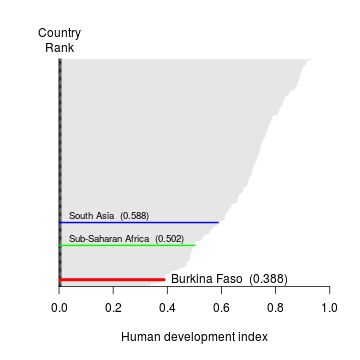
Human Development Index ranking and value
Human Development Index ranking for Burkina Faso. Data source: UNDP.
Gender¶
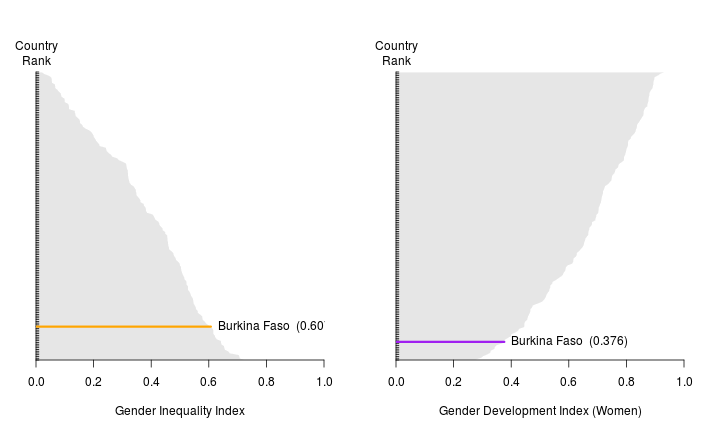
Gender Inequality and Development Indexes
Gender Inequality and Development Indices for Burkina Faso. Data source: UNDP.
Health and nutrition¶
Life expectancy at birth in Burkina Faso was only 39 in 1970 and has increased to only 56 in 2013 (UNICEF, 2014). Under-five mortality is barely under 10%, yet this is much reduced from the 32% it was in 1970 (UNICEF, 2014). The National Nutrition Survey (2012) estimates stunting, wasting, and underweight are 33%, 11%, and 24%, respectively. According to the survey, regions with the highest rates of stunting are Est (45%), Sahel (41%), and Cascades (40%); underweight is highest in Est (34%) and Centre Nord (30%). Disparities at the province level exist within regions. Stunting and underweight are significantly higher in rural households, while wasting is similar between rural and urban households. Stunting, wasting, and underweight all affect the poor in greater proportions than the wealthy.
According to the 2010 Burkina Faso Demographic and Health Survey (BFDHS), few women have short stature (height < 145 cm, NISD & ICF International, 2012). About 16% of women are underweight (BMI < 18.5) and 11% overweight or obese (BMI ≥ 25, NISD & ICF International, 2012). More than twice as many women are underweight in rural households than urban households (NISD & ICF International, 2012). Women in urban households are more than four times as likely to be overweight or obese as women in rural households (NISD & ICF International, 2012). Households with lower income are more likely to have women who are underweight and less likely to have women who are overweight or obese. Est has the highest proportion of women who are underweight (31%) and Centre has the highest proportion of women who are overweight or obese (27%, NISD & ICF International, 2012). No recent anthropometric data is available for men.

Child height-for-age Z-score and women’s body mass index
Average height-for-age Z-score for children (a child with a score less than -2 is considered stunted), and body mass index for women. Data source: DHS.
Micronutrients¶
To our knowledge, no nationally representative surveys that measure micronutrient deficiencies via biomarkers other than anemia (e.g., BFDHS) have been conducted in the country. The BFDHS estimates that 88% of children 6-59 months, 49% of women, and 29% of men are anemic. Half of mothers took iron syrup or tables for 90 days or more during their last pregnancy. A little over half of them (56.6%) also received a vitamin A dose postpartum (NISD & ICF International, 2012). For children 6-59 months, 63% received vitamin A supplements in the past 6 months, 7% were given iron supplements in the last 7 days, and 13% were given deworming medication in the last six months (NISD & ICF International, 2012). Complementary feeding to children 6-23 months of foods that are rich in vitamin A and iron falls far short of meeting micronutrient requirements. Encouragingly, most households (96%) in Burkina Faso used iodized salt (NISD & ICF International, 2012).
The proportion of households who had inadequate diets in Burkina Faso was 26% in 2008, but increased to 32% in 2012, largely in urban areas, due to higher than average food prices during the survey period in 2012 (WFP, 2014). Diets largely consist of cereals and vegetables. Consumption of animal foods declined while sugar and oil increased from 2008 to 2012. About 27% of food consumed comes from the household’s own production (WFP, 2014). Few nationally representative studies on food consumption or micronutrient biomarkers have been conducted. More data is required to understand the current nutrition situation in Burkina Faso and to develop effective interventions. Olney et al. (2014) demonstrated the effectiveness of introducing nutrition sensitive agricultural interventions, including behavioral modification, to improve nutrition in mothers and children during the first 1,000 days in Burkina Faso. A study in Ouagadougou by Becquey and Martin-Prevel (2010) found that especially organ meat, but also other flesh foods, fruits and vegetables high in vitamin A, and legumes and nuts, were associated with micronutrient adequacy in women of reproductive age. Furthermore, Nana et al. (2005) suggested that interventions with mango and liver could improve vitamin A intake of children in rural Burkina Faso. Many wild plants in Burkina Faso have a higher mineral density than cultivated plants and can help meet micronutrient needs, particularly during drought or political unrest (Smith et al., 1996).
The New Alliance for Food Security and Nutrition brings partners together on policy changes and investments African agriculture to benefit smallholder farmers and reduce hunger and poverty. They have a country report (in French) for Burkina Faso.

MicroNutruent Density Index
Micronutrient Density Index (MDI) between 1961 and 2011. Source: Beal et al.
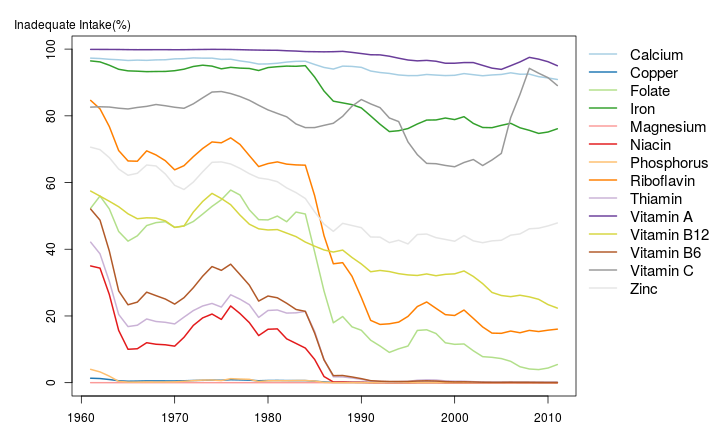
Prevalence of Inadequate Nutrient Intake
Estimated prevalence of inadequate intake (%) of micronutrients between 1961 and 2011. Source: Beal et al.
Land and water resources¶
Elevation¶
The elevation of Burkina Faso is between 140 and 700 meters above sea level. Half the land area is below 300 meter and in between 270 and 320 meter.
Climate¶
Burkina Faso has a Sahelian, warm tropical climate, with two distinct rainfall seasons (rainy and dry). Three broad climatic zones can be distinguished in Burkina Faso: the dry Sahelian north, the North Sudan zone in the center, and the more humid South Sudan region in the south. The Sahelian north has mean annual rainfall of 300-600 mm and a dry season of 7-9 months (October to June). The North Sudan zone in central Burkina Faso has mean annual rainfall of 600-900 mm, with a 4-5 month rainy season (June to October). The South Sudan region in the south has mean annual rainfall of 900-1200 mm, and a rainy season lasting up to 6-7 months (May to October) (FAO AQUASTAT).
The annual average temperature in Burkina Faso is between 25.8 and 29.6 °C. The median annual average temperature is 28.1 °C and half the land area has an annual average temperature between 27.7 and 28.4 °C. For more details see the monthly temperature maps. For projected future climate change, see these maps.
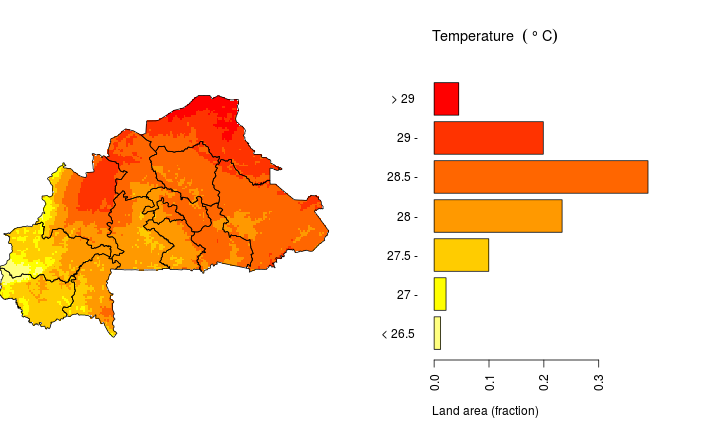
data source: WorldClim
Average annual mean temperature (°C) for 1950-2000 in Burkina Faso. Source WorldClim
The annual total precipitation in Burkina Faso is between 300 and 1190 mm. The median is 780 mm and half the land area has an annual total precipitation between 610 and 900 mm. For more details see the monthly precipitation maps. For projected future climate change, see these maps.
Soils¶
Soils in Burkina Faso are mostly Alfisols with a near neutral pH but low organic matter content.
Water¶
The three major river systems in Burkina Faso are tributaries of the Volta River, namely the Black, White, and Red Volta Rivers. The Volta River system covers 63% of the country, but other international river systems include the Niger (30% of land area, in the east and north) and the Komoé (7%, on the southwest border with Côte d’Ivoire).
Exploitable surface water resources are estimated to be 4750 km3 per year, or 280 m3 per year per capita in 2013.
Tube wells are also common in Burkina Faso, but only an estimated 25% of the population has access to clean water. Total renewable groundwater resources in the country are estimated at 12.5 km3/year. Arsenic contamination is a problem in Burkina Faso, as arsenic is naturally present in rock formations in northern Burkina Faso. Arsenic contamination of groundwater has led to issues that include skin disorders (Smedley, Knudsen, and Maiga 2007). The use of tube well irrigation is generally regarded as unsustainable in Burkina Faso, given the low levels of precipitation and groundwater recharge .
Burkina Faso has a multitude of low-capacity dams. According to FAO AQUASTAT’s Dams Database, there are currently 145 dams in Burkina Faso, but the entire capacity of the dams (6698 million m3) is not very high. The dams and reservoirs are mainly located in the central part of the country, in the the Volta River catchment.
Water policy and investment¶
The state owns all water resources including irrigated land in Burkina Faso. There are currently no direct or explicit water rights outside of customary rights. The state can expropriate land from farmers to establish new water infrastructure like irrigation networks. The 2001 Water Management Policy Act introduced strategies for an integrated water resources management approach (USAID, 2010b). The 2003-2015 Integrated Water Resources Management (PAGIRE) was established as a framework to implement this policy, promoting an integrated rather than sector-based approach, establishing the National Water Council and stable management structures.
Although public spending on irrigation has increased in the last few years, irrigated farmland accounted for less than one percent of the total agricultural area in use in 2013 (OECD, 2013). The 2004 Hydro-Agricultural Development Policy emphasizes user participation, and investment in small, medium, and large-scale irrigation schemes. It is not clear whether national-level policy frameworks on irrigation have been updated since this policy.
The Ministry of Agriculture and Food Security and the Ministry of Water, Hydraulic Resources, and Sanitation oversee water resources development and investment.

Map of Irrigated Agricultural Land
Percentage of agricultural land that is irrigated. Data source: GMIA
Weather index insurance in Burkina Faso has attracted the attention of NGOs, practitioners, and academics alike. For NGOs and practitioners, the PlaNetGuarantee has been offering index insurance for maize and cotton farmers in Burkina Faso since 2011. The project reaches 8,281 households, and the total insurance portfolio was $672,609 in 2013, with only one small payout of $960 for maize farmers in 2013. The same project is active in other parts of francophone West Africa, including Benin, Mali, and Senegal.
Berg et al (2009) and Siebert (2015) have assessed the potential use of weather insurance as an adaptation tool for farmers in Burkina Faso. Carter et al. (2015) have used field experiments to assess the buying behavior of cotton farmers in Burkina Faso. Dellavallade et al. (2015) investigate the differences in purchasing behavior for farmers in Burkina Faso and Senegal, concluding that female farmers are more likely to invest in savings accounts than agricultural insurance.
Land tenure¶
Land tenure has gone through meaningful reform in the last five years. Previous law did not recognize customary land rights as legal tenure even though customary allocation and transaction processes remained active in most of Burkina Faso. Policies established in the early 1990s attempted to privatize land rights and long-term leases, but poor implementation and enforcement led to insecure tenure. The 2009 Rural Land Tenure Law codifies these rights formally, enabling villages to create local land charters based on customary premises that are then sanctioned at the national level. These charters cover conservation, loans, and dispute management. Such a law implies that land tenure rules vary across villages. The new law also allows for individual possession and collective land rights, inheritance transfers, and verbal and written lease agreements. The codification of customary law does not imply that land is titled and registered, however. At current standing, the land becomes titled and owned only when a private operator purchases and registers it from the state. After it is titled, it can be freely bought and sold. Formalizing customary land rules should lead to the expansion of private titles in the future (USAID, 2010b).
Land-use disputes occur in Burkina Faso. Previous land disputes stemmed, in part, from uncertainty over land tenure rules. Dispute management was addressed in the 2009 law to an extent. According to the law, dispute settlement should be done at the local level and resolved within 45 days. Although the law specifies that litigation at higher levels be avoided, it is not yet clear whether the policy has achieved reductions in court action (most of which was ineffective in the past due to poor enforcement). These frameworks are purposed to buffer increasing land disputes between herders and farmers and between pastoralist communities that have emerged due to climate change (USAID, 2010b).
The Ministry of Agriculture, Water Resources and Fisheries, the Ministry of Environment, the Ministry of Animal Resources, the Ministry of Economy and Finances, and the Ministry of Territorial Administration and Decentralization are some of the agencies involved in land tenure and administration.
Food production¶
Crop production¶
The main food crops in Burkina Faso are Sorghum, Millet, Cowpea and Maize. Millet dominates in the dry north and maize in more humid south. The area planted with millet has been stable, at about 1.25 million ha over the past decades. The Sorghum area has increased, but not by as much as the cowpea and maize area, which has doubled over the past 15 years.
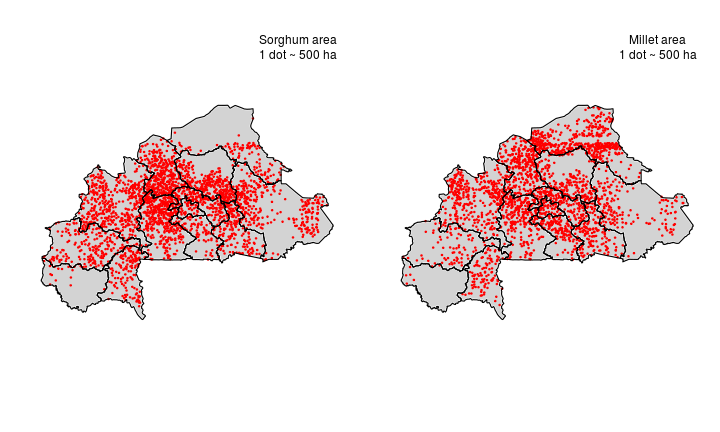
Cultivation Distribution
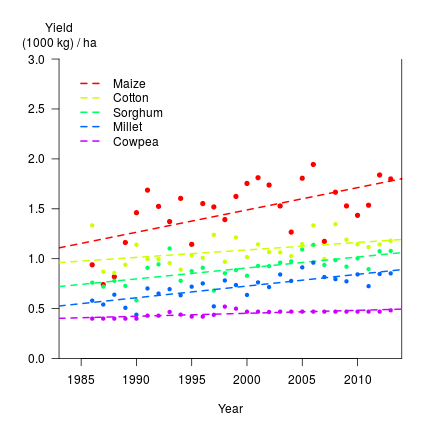
Crop Yield
Crop yield over the past 30 years, for the main five crops in Burkina Faso. Data source: FAO.
Annual linear growth rates of crop yield over the past 30 years, for the main five crops , were between 3 (Cowpea) and 22.3 (Maize) kg/ha
Livestock¶
The 2010-2015 National Sustainable Development Policy for Livestock aims to increase the contribution of the livestock sector to economic growth and nutritional security. Specifically, its objectives involve innovation capacity and public-private partnerships, securing pastoral land tenure, sustainable pastoral management, structural investment in feed, genetics and animal health, development market infrastructure, and promoting food safety and quality. The Action Plan and Investment Programme for the Livestock Sector implements the NSDPL, following earlier policy frameworks on livestock. It includes 12 priority programmes that reflect policy priorities. These include strengthening vocational training, building capacity of advisory and professional organizations, securing livestock production areas, improving pastoral water management, improving feed security, boosting the genetic potential of local breeds, and controlling animal diseases, among others (OECD 2013).
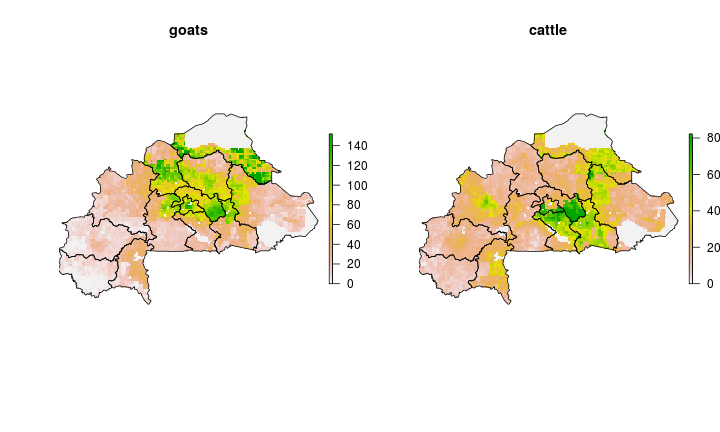
Livestock Distribution
Spatial distribution (head per km2) of goats and cattle in Burkina Faso. Data source: Gridded Livestock of the World. More livestock maps.
Aquaculture and fisheries¶
The reservoirs attached to the dams in Burkina Faso support a fledgling aquaculture industry, but it is not very well-developed. The National Water Policy and National Food Security Strategy address some policy issues regarding aquaculture and fisheries (OECD 2013). The policy framework and regulations in this sector seem well undefined and deficient. Anecdotal evidence suggests that the responsibility of aquaculture management has jumped from ministry to ministry, and that that few actors – including farmers – are aware of any macro-level policies that apply to the aquaculture sector (SUSFISH 2013).
Intensification¶
Burkina Faso has made substantial investments in agricultural development. Most of this investment has been targeted to particular sectors. Public spending averaged around 11.43 percent of the national budget from 1999-2008 (OECD 2013), thus making Burkina Faso one of the only African countries to reach the CAADP budget targets. Burkina has a number of policies that outline priorities and rules for the agriculture sector. These policies were streamlined into the 2011-2015 National Rural Sector Programme. Other policies include the National Food Security Strategy, National Water Policy, National Land-Use Planning Scheme, and the 2009 Rural Land Tenure Law.
The cotton sector is the most advanced in terms of policy supports and investment (including subsidies), but the focus on cotton has shifted toward staple production in recent years. Three private companies (with government-owned shares) manage cotton production and trade. Since 2008, set prices paid to producers for cotton has increased and more closely reflect prices on the international market (FAO 2014a).
Although cotton farmers continue to receive direct support, the 2007-2008 food crisis also led the government to increase support to farmers participating in staple crop production like sorghum, rice, and millet. Support involves the distribution of improved seeds and fertilizer subsidies as well as more general investment in things like training and infrastructure (MAFAP 2012). These investments led to an increase in rice production (ibid). A recent report finds that subsidies for improved seed were more effective than subsidies for fertilizer, but the reasons why are not clear (OECD 2013). Importantly, access to credit remains weak for non-cotton producers (OECD 2013).
The Government of Burkina Faso has invested in research and development, but spending trends have been erratic and reflect its dependence on donor assistance. The Environment and Agricultural Research Institute (INERA) is Burkina’s main research agency, but there are five others with a mix of sector and production focuses. Research agencies including INERA have worked closely with various cotton producer organizations and companies like SOFITEX and Nestle. In the late 2000s, however, INERA’s scientists researched sorghum and rice more than any other commodity. Almost all employees in INERA are trained at the Masters or PhD level (Stads and Kabore 2014).
Although Burkina Faso has invested in public spending for agriculture, public spending on other areas that affect the farm-to-market has been inadequate. Poor infrastructure, government responsiveness, and tax administration, along with weak domestic markets, limit the utility of direct agricultural investments like R&D and extension (OECD 2013).

Investment in Agricultural Research
Investment in Agricultural Research over time and by commodity groups ( data source: ASTI).
Yield gaps¶
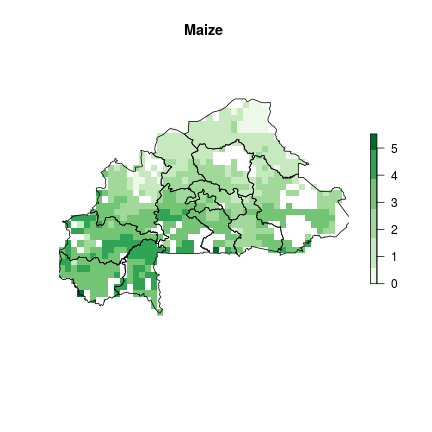
Yield Gap
Yield Gap (1000 kg / ha).
Selected research and development priorities and projects¶
The research programs within the CGIAR has a number of projects in Burkina Faso. The International Livestock Research Institute has research agendas on the enhancement of ecosystem services in pastoral systems, integrated management of crop-livestock agro-ecosystems in the Volta Basin, and livestock-based carbon sequestration. The Climate Change, Agriculture and Food Security Research Program has three research projects in Burkina Faso. The first focuses on identifying drought-resilient seeds, the second centers on the utility of germplasm and the impact of climate change on crops and production systems, and the third focuses on the policy processes concerning germplasm.The Water, Land and Ecosystems Research Program (WLE) is “working to achieve green, resilient and equitable growth.” The Volta River Basin is one of the focal regions of the WLE. The WLE conducts six different research projects in the Volta River Basin, including project for investment in the White Volta Basin.
There are several other water projects in Burkina Faso. The Partnership for Agricultural Water for Africa AgWA led by the FAO is active in several African countries, including Burkina Faso. AgWA is an autonomous voluntary partnership that seeks to develop synergy between national and international institutions, as well as provide technical support for The five priority areas are Advocacy, Partner Harmonization, Resource Mobilization, Generating and Sharing Knowledge, and Capacity Building. Specific to Burkina Faso, AgWA is conducting a project called Support to sustainable agricultural water management and the pre- and post-CAADP compact process in Burkina Faso, Morocco and Uganda. The project seeks to improve agricultural water management, enhance capacity for water efficiency, and enhance water harvesting capacity in the there countries. The Agricultural Water Solutions Project (AWM) PDF, active from 2008-2011, is a project by a consortium of research, scientific, and commercial organizations that seeks to unlock the potential of smallholder farmers in many countries around the world, including Burkina Faso. The AWM focuses on addressing the needs of target populations rather than focusing on the development of additional water resources. One focus of the AWM is on mapping livelihoods, in order to understand the needs of the constituent farmers. Established in 2002, the Global Water Partnership is active in Burkina with projects that include mapping the vulnerability of water resources in the Volta Basin as well as work on governance, improved seeds, and gender mainstreaming.
Emphases within the most recent Poverty Reduction Strategy Paper include guiding the emergence of agricultural small and medium-sized enterprises (SMEs), improving land tenure security, the national strategy for the integrated management of soil fertility, increasing marketing and processing, and enhancing agricultural research and outreach activities. Specific objectives in sub-sectors include focusing on achieving returns in cereals, oilseeds, vegetables (especially cowpeas), and cotton through supplying access to improved seeds and other inputs; developing cooperation and organization among livestock producers and research centers and increasing livestock productivity through nutrition and animal health (particularly in dairy) (IMF PRSP 2011-2015).
The US (African Development Foundation)[http://www.adf.gov/] supports many projects in Burkina Faso
Nature conservation¶
About 15% of terrestrial Burkina Faso is under some form of protection (IUCN & WDPA 2015). This includes three national parks (Category II), and nine habitat/species management areas (Category IV), as defined by the IUCN. Across Burkina Faso UNESCO has designated two Biosphere Reserves, the Mare aux hippopotames (about 60 km north of Bobo-Dioulasso in south-west Burkina Faso), and the ‘W’ Region transboundary Biosphere Reserve (Benin/Burkina Faso/Niger). Additionally, the country contains 15 Ramsar Wetlands of International Importance.
Burkina Faso is home to 25 species on the IUCN Red List of threatened and endangered species. This includes one species that is Extinct in the Wild, one listed as Critically Endangered, six as Endangered, and 17 as Vulnerable. However, Burkina Faso does not contain any sites noted by the Alliance for Zero Extinction as locations having an imminent risk of species extinctions.
African Wildlife Foundation is the only major global or regional environmental non-governmental organization with a current conservation program in Burkina Faso. They operate in and around the Regional Parc W.
Global conservation prioritization methodologies have highlighted a total of 5% of Burkina Faso as having conservation importance. This includes Important Bird Areas (5% of the country) and regions considered to be the Last of the Wild (1%) as defined by Wildlife Conservation Society. However, no area in the country is recognized as a Biodiversity Hotspot (Conservation International) or a Frontier Forest (Global Forest Watch). Nor does Burkina Faso contain any portion of the Global 200 Ecoregion network (World Wildlife Fund).
The map on the left (below) shows biodiversity conservation priorities generated by combining numbers of vertebrate species, (excluding reptiles), IUCN threatened species, and small-ranged species (data from Jenkins et al. 2013) per 10 km2 cell. Thus, the areas with the highest values (shown here in red) not only have the greatest diversity of species in Burkina Faso, but also show those areas where species are or might become threatened with extinction. The map on the right highlights 17% of the terrestrial area of Burkina Faso containing the highest conservation priority values (a 17% target was chosen in accordance with the 2010 Convention of Biological Diversity). The same analysis at both regional and global scales highlights 5% and 0% of the nation respectively as meeting the CBD targets as defined in this analysis.
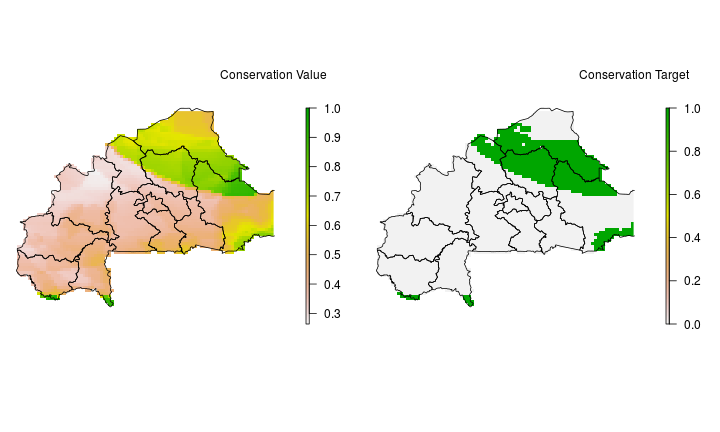
Conservation Priorities
Conservation Priorities.
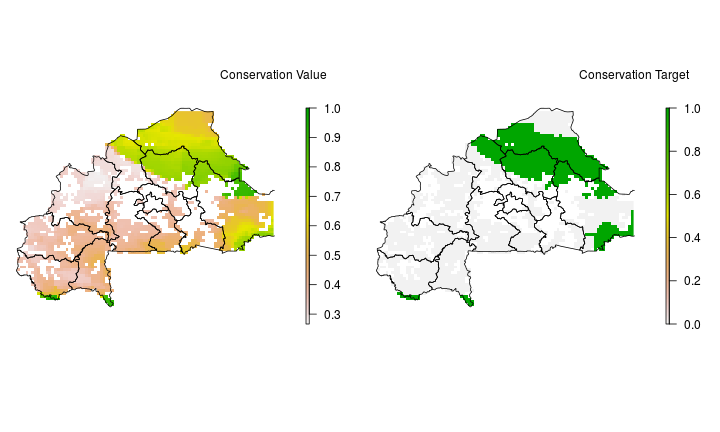
Conservation Priorities excluding Urban and Agricultural land
Conservation Priorities excluding Urban and Agricultural land.
Political system¶
Burkina Faso has a history of coups and military involvement in politics; the country is ‘partly free’ according to Freedom House. Burkina Faso has also experienced single-party and single-leader rule for almost all of its post-colonial existence. In October 2014, after ex-President Compaore of the Congress for Democracy and Progress Party (CDP) pushed the legislature to extend the presidential term limit, a military coup and large public protests led to the collapse of the regime. President Compaore, who maintained considerable power throughout his presidency (Hilgers 2010), relinquished authority and Foreign Minister Michel Kafando was established as the Interim President for one year. Although patronage, clientelism, and patrimony characterize the political environment in Burkina Faso (Hilgers 2010), corruption has been decreasing since the early 2000s (Heritage Foundation 2015).
Executive structure¶
Burkina Faso’s 1991 Constitution establishes the system as president-parliamentary. The President is elected via a two-round majority runoff for a five-year fixed term, he appoints the Prime Minister (PM), and can dissolve the national assembly upon consultation with the PM. Ex-President Campaore seized power through a coup in 1987 and remained president for 27 years. He consistently obtained around 80 percent of the vote share in presidential campaigns in the last 15 years. Although 6-10 other candidates compete in elections, they collect very few votes.
According to the Constitution, the President has both strong legislative and cabinet powers. He can submit referenda to any bill that concerns national interest. During promulgation, the President can also demand a second reading of a law or its articles, which results in the law entering enforcement. The president has both strong veto and decree powers (Constitution of Burkina Faso 1991).
Relevantly, entry to presidential elections is somewhat restricted. Every candidate must be formally endorsed by at least 50 elected MPs or local councilors. If the endorsement comes from only local councilors, the councilors must represent at least half of the country’s regions. Elected officials can only give their endorsement to one candidate. Presidential candidates are also required to pay a deposit of approximately 20,000 USD, which is returned to any candidate who receives at least 5 percent of the vote share (Center for African Studies 2015). These entry restrictions are barriers to entry for opposition parties and candidates.
Electoral Rules and party arrangement¶
The National Assembly has 111 seats and its members are elected for five-year terms by closed-list proportional representation in 45 districts. Of these districts, 37 have magnitudes of two. Research has shown that two-seat districts with non-plurality rules systematically favor the second-largest party instead of the smallest parties (cite). In Burkina Faso, the second-largest party is the Alliance for Democracy and Federation-African Democratic Rally (ADF-RDA). Although the CDC has had the overwhelming majority of seats in the National Assembly in past years, without a district magnitude that benefits the second-largest party, the CDC would have even more seats (Shugart 2014). In 2007, the CDP had 73 seats, the ADF-RDA obtained only 14, and eleven small parties accounted for the remaining seats (all with five seats or less). Burkina Faso’s Parliament is unicameral.
Constitutional rules and laws that govern party establishment are quite liberal compared to other African countries. One of the only restrictions to creating a political party is that party affiliation cannot be based on “tribalism, regionalism, religious affiliation, or racism” (Constitution of Burkina Faso 1991). Although there were 104 legally recognized political parties in 2013 (Center for African Studies 2015), the percentage of these parties that actually make it into the legislature is significantly lower.
It has been suggested that one reason for opposition weakness in Burkina Faso may be due to the executive’s engagement with certain members of the opposition parties. In the 2000 election for example, the Prime Minister made a coalition with eight of the opposition parties. Inviting parties into government was not likely a strategy to form a majority as is often the case in assemblies with many parties and more symmetric sharing of seats, but was a strategy to divide parties by allying with some members and not with others. This leads to internal conflict and divisions within the opposition parties (Hilgers 2010). Additional reasons for weakness in opposition are rules that incentivize party fracturing. Since party leaders are charged with assigning candidates to lists and independents can run in elections, any candidate who is not assigned on a party list can leave the party and run as an independent candidate (Center for African Studies 2015).
Decentralization¶
Burkina Faso is decentralized according to the 1991 Constitution and a series of laws like the 2004 General Code of Territorial Collectivities. It was not until the late 2000s that all local government units were established, elected, and given effectual authority over government activities. Burkina Faso’s 351 communes elect their municipal councils every five years (Constitution of Burkina Faso 1991). The municipal councils then select the mayors. The local governments are responsible for administration and implementation of policy. They can levy some taxes, but not the most important ones, which remain in control of the central government (World Bank 2009). Despite legal decentralization, rural communes suffer from weak capacity, limited financial autonomy, and exist in a complex web of devolved government structures including the provincial government (Englebert and Sangare 2014).
The Ministry of Territorial Administration and Decentralization (MATD) oversees the implementation of decentralization processes.
References¶
- Becquey, E., & Martin-Prevel, Y., 2010. Micronutrient adequacy of womens diet in urban Burkina Faso is low. The Journal of Nutrition 140: 2079S-2085S.
- Berg, Alexis, Philippe Quirion, and Benjamin Sultan, 2009. Weather-index drought insurance in Burkina-Faso: assessment of its potential interest to farmers. Weather, Climate, and Society 1.1: 71-84.
- Birner, R., Kone, S. A., Linacre, N., & Resnick, D., 2007. Biofortified foods and crops in West Africa: Mali and Burkina Faso. AgBioforum 10: 192-200.
- Carter, Michael, Ghada Elabed, and Elena Serfilippi, 2015. Behavioral economic insights on index insurance design. Agricultural Finance Review 75.1.
- Center for African Studies. 2015. The Electoral System: Burkina Faso. University of Florida. http://sahelresearch.africa.ufl.edu/tsep/themesissues/the-electoral-system/burkina-faso/.
- Constitution of Burkina Faso. 1991.
- Delavallade, Clara, et al., 2015 Managing Risk with Insurance and Savings: Experimental Evidence for Male and Female Farm Managers in West Africa.
- Englebert, Pierre, and Nestorine Sangare. 2014. Burkina Faso: Limited Decentralization Under Tight Oversight. In: Lynne Reinner, Decentralization in Africa, p 45–68.
- FAO. 2014a. Country Fact Sheet on Food and Agriculture Policy Trends: Burkina Faso.
- Forzieri, Giovanni, et al., 2008. A methodology for the pre-selection of suitable sites for surface and underground small dams in arid areas: A case study in the region of Kidal, Mali. Physics and Chemistry of the Earth, Parts A/B/C 33.1: 74-85.
- GoBF. 2010. Livestock Sector Development Strategy. Burkina Faso: Government of Burkina Faso.
- Hilgers, Mathieu, 2010. Evolution of Political Regime and Evolution of Popular Political Representations in Burkina Faso. African Journal of Political Science and International Relations 4(9): 350–59.
- MAFAP. 2012. Burkina Faso: MAFAP Country Profile. FAO. Monitoring African Food and Agricultural Policies.
- Ministry of Agriculture, Water Resources and Fisheries. 2004. National Sustainable Development Policy of irrigated agriculture: strategy, action plan and investment plan, 2015 (PNDDAI).
- Ministry of Environment and Water, 2001. State Water Resources places of Burkina Faso and their management framework.
- Ministry of Health Burkina Faso, 2012. National Nutrition Survey 2012.
- Nana, C. P., Brouwer, I. D., Zagré, N. M., Kok, F. J., & Traoré, A. S., 2005. Community assessment of availability, consumption, and cultural acceptability of food sources of (pro) vitamin A: toward the development of a dietary intervention among preschool children in rural Burkina Faso. Food & Nutrition Bulletin, 26: 356-365.
- National Institute of Statistics and Demography (NISD) & ICF International, 2012. Demographic and Health Survey and Multiple Indicator of Burkina Faso 2010. Calverton, Maryland, USA: NISD and ICF International.
- OECD. 2013. Policy Framework for Investment in Agriculture in Burkina Faso. OECD.
- Olney, D. K., A. Pedehombga, M. Ruel, and A. Dillon, 2014. The Impacts of an Integrated Agriculture and Nutrition and Health Behavior Change Communication Program Targeted to Women in Burkina Faso on Childrens Growth, Anemia, and Diarrhea: A Cluster-Randomized Controlled Trial. Washington, DC: International Food Policy Research Institute. Unpublished manuscript.
- Shugart, Matthew. 2014. Visualizing the Impact of Two-Seat Districts. Fruits and Votes. https://fruitsandvotes.wordpress.com/2014/11/02/visualizing-the-impact-of-two-seat-districts/.
- Siebert, A., 2015. Assessing the viability of index insurance as an adaptation tool in a changing climate context: case Study in the West African Sahel. Diss. Rutgers University-Graduate School-New Brunswick.
- Smedley, P. L., J. Knudsen, and D. Maiga, 2007. Arsenic in groundwater from mineralised Proterozoic basement rocks of Burkina Faso. Applied Geochemistry 22.5: 1074-1092.
- Smith, G. C., Clegg, M. S., Keen, C. L., & Grivetti, L. E., 1996. Mineral values of selected plant foods common to southern Burkina Faso and to Niamey, Niger, West Africa. International Journal of Food Sciences and Nutrition 47: 41-53.
- Stads, Gert-Jan, and Sawadogo Kabore. 2014. Recent Developments in Agricultural Research: Burkina Faso. ASTI (IFPRI).
- UN Children’s Fund (UNICEF), 2014. The State of the World’s Children 2015: Reimagine the Future: Innovation for Every Child. UNICEF.
- USAID. 2010b. Property Rights and Resource Governance in Burkina Faso. USAID.
- World Bank. 2009. Local Government Discretion and Accountability: Application of a Local Governance Framework. Washington DC: World Bank.
- World Food Programme (WFP), 2014. Comprehensive Food Security and Vulnerability Analysis (CFSVA): Burkina Faso. WFP.
